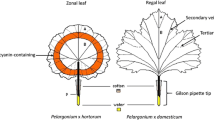Abstract
We tested the hypothesis that Lima bean Phaseolus lunatus L. (Henderson cultivar) trichome density affects the survival of the acariphagous lady beetle Stethorus punctillum Weise. When isolated throughout larval development, 10% or less of S. punctillum larvae reared on two-spotted spider mite Tetranychus urticae Koch on small (rather than large) P. lunatus leaves survived until pupation. Although other factors might have contributed to larval mortality, we demonstrated that survival rate was related to trichome density (i.e., number of hooked trichomes per cm on the underside of leaves). Trichome density was greatest on the underside of small leaves and least on large leaves, indicating that survival rate increased as trichome density decreased. Hooked trichomes impaled S. punctillum larvae more often at the apex of the abdomen than at any other body part. Hooked trichomes also trapped S. punctillum adults, but they always managed to free themselves. This study highlights the negative effect of Lima bean hooked trichomes on a predacious lady beetle that attacks the two-spotted spider mite.


Similar content being viewed by others
References
Barbour JD, Farrar RR Jr, Kennedy GG (1997) Populations of predaceous natural enemies developing on insect-resistant and susceptible tomato in North Carolina. Biol Control 9:173–184
Biddinger DJ (1993) Toxicity, stage specificity, and sublethal effects of abamectin and several classes of insect growth regulators to Platynota idaeusalis (Lepidoptera: Tortricidae) and Stethorus punctum (Coleoptera: Coccinellidae). PhD. Dissertation, The Pennsylvania State University
Biddinger DJ, Weber DC, Hull LA (2009) Coccinellidae as predators of mites: Stethorini in biological control. Biol Control 51:268–283
Bottrell DG, Barbosa P, Gould F (1998) Manipulating natural enemies by plant variety selection and modification: a realistic strategy? Annu Rev Entomol 43:347–367
Eisner T, Eisner M, Hoebeke ER (1998) When defense backfires: detrimental effect of a plant’s protective trichomes on an insect beneficial to the plant. Proc Natl Acad Sci USA 95:4410–4414
Johnson B (1953) The injurious effects of the hooked epidermal hairs of French beans (Phaseolus vulgaris L.) on Aphis craccivora Koch. Bull Entomol Res 44:779–788
Kavousi A, Chi H, Talebi K, Bandani A, Ashouri A, Naveh VH (2009) Demographic traits of Tetranychus urticae (Acari: Tetranychidae) on leaf discs and whole leaves. J Econ Entomol 102:595–601
Lambert AM (2007) Effect of prey availability, facultative plant feeding, and plant defenses on a generalist insect predator. Arthropod-Plant Interact 1:167–173
Levin DA (1973) The role of trichomes in plant defence. Q Rev Biol 48:3–15
Loughner R, Goldman K, Loeb G, Nyrop J (2008) Influence of leaf trichomes on predatory mite (Typhlodromus pyri) abundance in grape varieties. Exp Appl Acarol 45:111–122
Oku K, Yano S, Takafuji A (2006) Host plant acceptance by the phytophagous mite Tetranychus kanzawai Kishida is affected by the availability of a refuge on the leaf surface. Ecol Res 21:446–452
Pérez-Estrada LB, Canto-Santan Z, Oyama K (2000) Variation in leaf trichomes of Wigandia urens: environmental factors and physiological consequence. Tree Physiol 20:629–632
Pillemer EA, Tingey WM (1976) Hooked trichomes: a physical barrier to a major agricultural pest. Science 193:482–484
Putman WL (1955) Bionomics of Stethorus punctillum Weise (Coleoptera: Coccinellidae) in Ontario. Can Entomol 87:9–33
Quiring DT, Timmins PR, Park SJ (1992) Effect of variations in hooked trichome densities of Phaseolus vulgaris on longevity of Liriomyza trifolii (Diptera: Agromyzidae) adults. Environ Entomol 21:1357–1361
Raworth DA (2001) Development, larval voracity, and greenhouse releases of Stethorus punctillum (Coleoptera: Coccinellidae). Can Entomol 133:721–724
Ricci C, Cappelletti G (1988) Relationship between some morphological structures and locomotion of Clitostethus arcuata Rossi (Coleoptera: Coccinellidae), a whitefly predator. Frust Entomol 11:195–202
Rott AS, Ponsonby DJ (2000a) The effects of temperature, relative humidity and host plant on the behaviour of Stethorus punctillum as a predator of the two-spotted spider mite, Tetranychus urticae. BioControl 45:155–164
Rott AS, Ponsonby DJ (2000b) Improving the control of Tetranychus urticae on edible glasshouse crops using a specialist coccinellid (Stethorus punctillum Weise) and a generalist mite (Amblyseius californicus McGregor) as biocontrol agents. Biocontrol Sci Technol 10:487–498
Scriven GT, Fleschner CA (1960) Insectary production of Stethorus species. J Econ Entomol 53:982–985
Shah MA (1982) The influence of plant surfaces on the searching behaviour of coccinellid larvae. Entomol Exp Appl 31:377–380
Valkama E, Salminen J-P, Koricheva J, Pihlaja K (2004) Changes in leaf trichomes and epicuticular flavonoids during leaf development in three birch taxa. Ann Bot 94:233–242
van Lenteren JC (2003) Commercial availability of biological control agents. In: van Lenteren JC (ed) Quality control and production of biological control agents, theory and testing procedures. CABI Publishing, Oxon, pp 167–179
Verheggen FJ, Capella Q, Schwartzberg EG, Voigt D, Haubruge E (2009) Tomato-aphid-hoverfly: a tritrophic interaction incompatible for pest management. Arthropod-Plant Interact 3:141–149
Voigt D, Gorb E, Gorb S (2007) Plant surface–bug interactions: Dicyphus errans stalking along trichomes. Arthropod-Plant Interact 1:221–243
Walters PJ (1974) A method for culturing Stethorus spp. (Coleoptera: Coccinellidae) on Tetranychus urticae (Koch) (Acarina: Tetranychidae). J Austral Entomol Soc 13:245–246
Wilson LJ (1994) Plant-quality effect on life-history parameters of the two spotted spider mite (Acari: Tetranychidae) on cotton. J Econ Entomol 87:1665–1673
Zhang Z-Q (2003) Mites of greenhouses: identification, biology and control. CABI Publication, Oxon
Acknowledgments
J. Morales and G. Rojas supplied two-spotted spider mite-infested Lima bean leaves for some of our experiments. Alvin Simmons, Ana I. Legrand, and David J. Biddinger commented on an earlier version of this manuscript. The remarks of three anonymous peer reviewers helped to improve the text. The United States Government has the right to retain a non-exclusive, royalty-free license in and to any copyright of this article. This article reports the results of research only. Mention of a commercial or proprietary product does not constitute an endorsement of the product by the United States Department of Agriculture.
Author information
Authors and Affiliations
Corresponding author
Additional information
Handling Editor: Arne Janssen
Rights and permissions
About this article
Cite this article
Riddick, E.W., Wu, Z. Lima bean–lady beetle interactions: hooked trichomes affect survival of Stethorus punctillum larvae. BioControl 56, 55–63 (2011). https://doi.org/10.1007/s10526-010-9309-7
Received:
Accepted:
Published:
Issue Date:
DOI: https://doi.org/10.1007/s10526-010-9309-7




